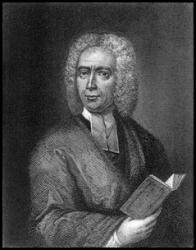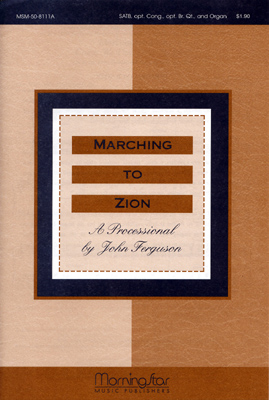- |
User Links
Come, we that love the Lord

Come, we that love the Lord, And let our joys be known
Author: Isaac Watts (1707)Tune: MARCHING TO ZION (Lowry)
Published in 1838 hymnals
Printable scores: PDF, MusicXMLPlayable presentation: Lyrics only, lyrics + musicAudio files: MIDI, Recording
Representative Text
1 Come, we that love the Lord,
and let our joys be known;
join in a song with sweet accord,
and thus surround the throne.
2 Let those refuse to sing
who never knew our God;
but children of the heav'nly King
may speak their joys abroad.
3 The hill of Zion yields
a thousand sacred sweets
before we reach the heav'nly fields,
or walk the golden streets.
4 Then let our songs abound,
and every tear be dry;
we're marching through Emmanuel's ground
to fairer worlds on high.
Source: Psalms and Hymns to the Living God #162
Author: Isaac Watts
 Isaac Watts was the son of a schoolmaster, and was born in Southampton, July 17, 1674. He is said to have shown remarkable precocity in childhood, beginning the study of Latin, in his fourth year, and writing respectable verses at the age of seven. At the age of sixteen, he went to London to study in the Academy of the Rev. Thomas Rowe, an Independent minister. In 1698, he became assistant minister of the Independent Church, Berry St., London. In 1702, he became pastor. In 1712, he accepted an invitation to visit Sir Thomas Abney, at his residence of Abney Park, and at Sir Thomas' pressing request, made it his home for the remainder of his life. It was a residence most favourable for his health, and for the prosecution of his literary… Go to person page >
Isaac Watts was the son of a schoolmaster, and was born in Southampton, July 17, 1674. He is said to have shown remarkable precocity in childhood, beginning the study of Latin, in his fourth year, and writing respectable verses at the age of seven. At the age of sixteen, he went to London to study in the Academy of the Rev. Thomas Rowe, an Independent minister. In 1698, he became assistant minister of the Independent Church, Berry St., London. In 1702, he became pastor. In 1712, he accepted an invitation to visit Sir Thomas Abney, at his residence of Abney Park, and at Sir Thomas' pressing request, made it his home for the remainder of his life. It was a residence most favourable for his health, and for the prosecution of his literary… Go to person page >Text Information
| First Line: | Come, we that love the Lord, And let our joys be known |
| Title: | Come, we that love the Lord |
| Author: | Isaac Watts (1707) |
| Meter: | 6.6.8.6 |
| Language: | English |
| Notes: | Spanish translation: "A Sion caminamos" by Vicente Mendoza; Swahili translation: See "Mpendao Bwana" |
| Copyright: | Public Domain |
- (hymns)
- (hymns)
- (hymns)
- (hymns)
- (hymns)
- (hymns)
- (hymns)
- (hymns)
- (hymns)
- (hymns)
- (hymns)
- (hymns)
- (hymns)
- (hymns)
- (hymns)
- (hymns)
- (hymns)
- (hymns)
- (hymns)
- (hymns)
- (hymns)
- (hymns)
- (hymns)
- (hymns)
- (hymns)
- (hymns)
- (hymns)
- (hymns)
- (hymns)
- (hymns)
- (hymns)
- (hymns)
- (hymns)
- (hymns)
- (hymns)
- (hymns)
- (hymns)
- (hymns)
- (hymns)
- (hymns)
- (hymns)
- (hymns)
- Year A, Ordinary Time, Proper 11 (16)
- Year A, Ordinary Time, Proper 19 (24)
- Year B, Epiphany season, Third Sunday
- Year C, Ordinary Time, Proper 16 (21)
This is recommended for Year C, Ordinary Time, Proper 16 (21) by 2 hymnal lectionary indexes.
English
- 112 Familiar Hymns and Gospel Songs #48
- 20th Century Gospel Songs #33
- A Baptist Hymn Book, Designed Especially for the Regular Baptist Church and All Lovers of Truth #d155
- A Book of Hymns for Public and Private Devotion. (10th ed.) #3
- A Book of Worship for the Use of the Evangelical Lutheran Church ... of the Church of the Redeemer, Richmond, Virginia #d27
- A Choice Collection of Hymns, and Spiritual Songs, designed for the devotions of Israel, in prayer, conference, and camp-meetings...(2nd ed.) #131
- A Choice Selection of Evangelical Hymns, from various authors: for the use of the English Evangelical Lutheran Church in New York #309
- A Choice Selection of Hymns and Spiritual Songs for the use of the Baptist Church and all lovers of song #390
- A Choice Selection of Hymns. 2nd ed. #d49
- A Choice Selection of Hymns. 6th ed. #d58 10 shown out of 1188
German
Spanish
Notes
Come, we [ye] that [who] love the Lord. I. Watts. [Joy and Praise.] First published in his Hymns & Sacred Songs, 1707, and again, 2nd ed., 1709, Bk. ii., No. 30, in 10 stanzas of 4 lines, and entitled "Heavenly Joy on Earth." In its original and full form it is rarely found in modern collections, the New Congregational Hymn Book, 1859, No. 693, and the Baptist Psalms & Hymns, 1858-80, being exceptions with the alteration of stanza iii., line 3, of "fav'rites" to "children." It has undergone many alterations and revisions. Of these the principal are:—
1. "Come ye that love the Lord." This was given by J. Wesley in his Psalms & Hymns, published at Charlestown, U. S., 1736-7, during his stay in Georgia. In this form stanzas ii. and ix. are omitted, and the rest are considerably altered. After slight revision this text was repeated by Wesley in the Wesleyan Hymn Book, 1780, and is in the revised edition, 1875, and in most collections of the Methodist communion.
2. "Come ye who love the Lord." This reading of the first line was given by Cotterill in the 8th ed. of his Selection, 1819, and is followed in Hymnal Companion and others.
The different arrangement of stanzas, and the variations in the text which have been adopted by the numerous editors who have used it in one form or another may be counted by the hundred. The example set by Wesley in 1736, was followed by Whitefield, 1753; Madan, 1760; Conyers, 1772; Toplady, 1776, and onwards to the latest modern collection. No text can, as a rule, be relied upon. The original is easy to obtain in modern editions of Watts. The hymn, as a whole, is regarded as a good specimen of Watts's powers.
--John Julian, Dictionary of Hymnology (1907)
Access an additional article on the Canterbury Dictionary of Hymnology:
Tune
MARCHING TO ZION (Lowry)ST. THOMAS (Williams)
ST. THOMAS is actually lines 5 through 8 of the sixteen-line tune HOLBORN, composed by Aaron Williams (b. London, England, 1731; d. London, 1776) and published in his Collection (1763, 1765) as a setting for Charles Wesley's text "Soldiers of Christ, Arise" (570). The harmonization is by Lowell Maso…
Timeline
Arrangements
Media
The United Methodist Hymnal #732
The United Methodist Hymnal #733
Worship and Rejoice #67
- Audio recording from African American Heritage Hymnal #590
- MIDI file from Bradbury's Golden Shower of S.S. Melodies: a new collection of hymns and tunes for the Sabbath school #34
- MIDI file from Baptist Hymnal 1991 #524
- MIDI file from Baptist Hymnal 1991 #524
- MIDI file from Baptist Hymnal 1991 #525
- Audio recording from Baptist Hymnal 2008 #392
- MIDI file from Crowning Day No. 2 #152
- Audio recording from Celebrating Grace Hymnal #550
- MIDI file from The Cyber Hymnal #4165
- Audio recording from Evangelical Lutheran Worship #625
- Audio recording from Lift Up Your Hearts: psalms, hymns, and spiritual songs #483
- Audio recording from Lift Up Your Hearts: psalms, hymns, and spiritual songs #483
- Audio recording from Lift Up Your Hearts: psalms, hymns, and spiritual songs #483
- Audio recording from The New Century Hymnal #379
- Audio recording from The Southern Harmony, and Musical Companion (New ed. thoroughly rev. and much enl.) #10
- MIDI file from The Southern Harmony, and Musical Companion (New ed. thoroughly rev. and much enl.) #10
- Audio recording from The Southern Harmony, and Musical Companion (New ed. thoroughly rev. and much enl.) #23
- MIDI file from The Southern Harmony, and Musical Companion (New ed. thoroughly rev. and much enl.) #23
- Audio recording from Trinity Hymnal (Rev. ed.) #700
- MIDI file from Tabernacle Hymns: No. 2 #222
- MIDI file from The United Methodist Hymnal #732
- Audio recording from The United Methodist Hymnal #732
- MIDI file from The United Methodist Hymnal #733
- Audio recording from The United Methodist Hymnal #733
- MIDI file from Worship and Rejoice #67
- MIDI file from Worship and Rejoice #390


 My Starred Hymns
My Starred Hymns





